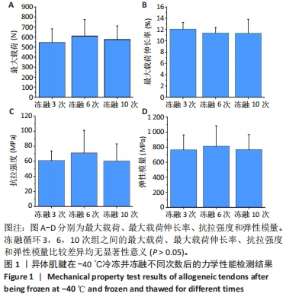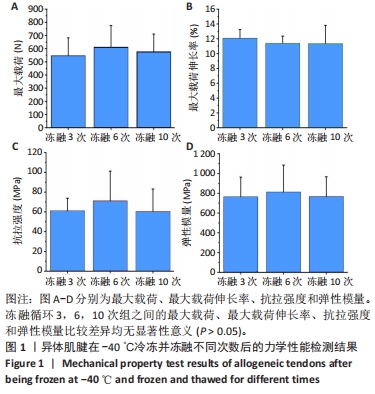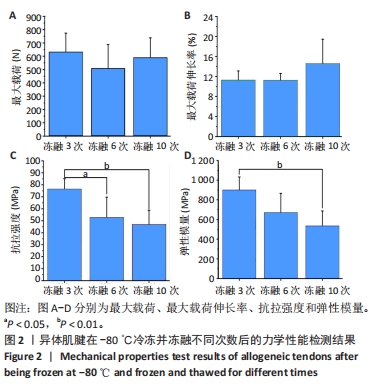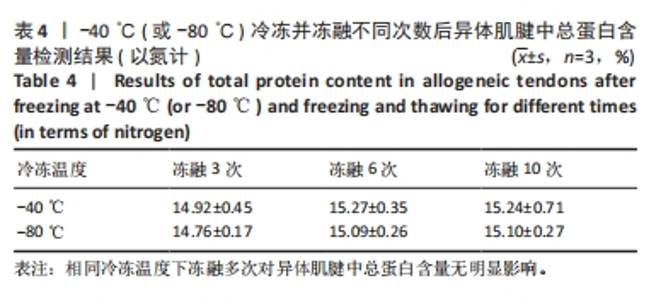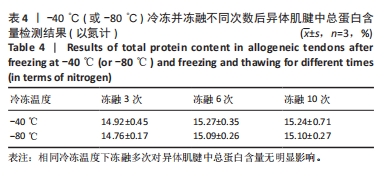Chinese Journal of Tissue Engineering Research ›› 2025, Vol. 29 ›› Issue (28): 6046-6051.doi: 10.12307/2025.487
Previous Articles Next Articles
Changes in properties of treated allogeneic tendons after multiple freeze-thaw cycles
Hu Kai1, Guo Yongqin1, Shao Yiran1, Wang Jingjing2
- 1Shanghai Gencong Biomedical Materials Research Center, Shanghai 201201, China; 2Shanghai Yapeng Biotechnology Co., Ltd., Shanghai 201201, China
-
Received:2024-05-21Accepted:2024-07-27Online:2025-10-08Published:2024-12-07 -
Contact:Hu Kai, MS, Shanghai Gencong Biomedical Materials Research Center, Shanghai 201201, China -
About author:Hu Kai, MS, Shanghai Gencong Biomedical Materials Research Center, Shanghai 201201, China -
Supported by:Pudong New Area Science and Technology Development Fund Industry-University-Research Special Project (Biomedicine), No. PKX2023-S15 (to WJJ)
CLC Number:
Cite this article
Hu Kai, Guo Yongqin, Shao Yiran, Wang Jingjing. Changes in properties of treated allogeneic tendons after multiple freeze-thaw cycles[J]. Chinese Journal of Tissue Engineering Research, 2025, 29(28): 6046-6051.
share this article
Add to citation manager EndNote|Reference Manager|ProCite|BibTeX|RefWorks
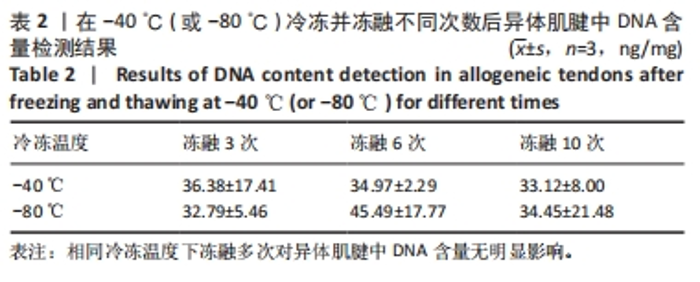
从图1可以看出,在-40 ℃条件下冷冻保存,冻融循环3,6,10次组之间的最大载荷、最大载荷伸长率、抗拉强度和弹性模量比较差异均无显著性意义(P > 0.05)。 从图2可以看出,与-40 ℃不同,在-80 ℃条件下冷冻储存,冻融循环3,6,10次组之间的最大载荷、最大载荷伸长率比较差异无显著性意义(P > 0.05),冻融循环3次组抗拉强度高于冻融循环6,10次组(P < 0.05,P < 0.01),冻融循环3次组弹性模量高于冻融循环10次组 (P < 0.01)。 -40 ℃条件下冻融肌腱与-80 ℃条件下冻融肌腱非同一具供体肌腱,因此无可比性。从最大载荷上看,所有样品的数值均在500-650 N之间。 2.2 异体肌腱的成分检测结果 异体肌腱的成分是决定其生物相容性的主要原因。为了比较不同冷冻温度条件下冻融次数对异体肌腱成分的影响,对各冻融次数下的肌腱样品进行DNA、硫酸糖胺聚糖、羟脯氨酸和总蛋白含量检测。 2.2.1 DNA含量 对异体肌腱在不同温度下冻融循环多次后残留的DNA含量进行测定,结果见表2。"

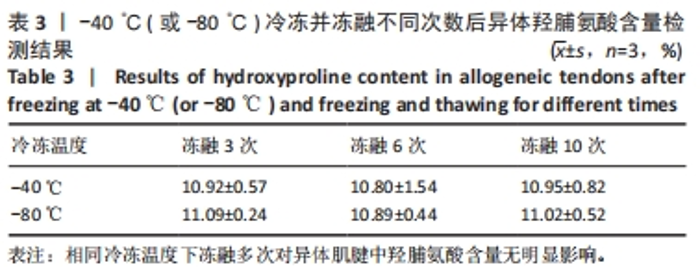
取异体肌腱致密端部分进行DNA含量检测,从数据结果上看,各组异体肌腱中DNA含量基本在30-50 ng/mg之间,相同温度下冻融多次对异体肌腱中DNA含量无明显影响。-40 ℃条件下冻融肌腱与-80 ℃条件下冻融肌腱非同一具供体肌腱,因此无可比性。 2.2.2 硫酸糖胺聚糖含量 硫酸糖胺聚糖是异体肌腱的主要成分之一,对异体肌腱不同温度下冻融循环多次后,异体肌腱中硫酸糖胺聚糖含量进行测定,结果见图3。结果显示,无论是-40 ℃还是-80 ℃冷冻并冻融多次,异体肌腱中硫酸糖胺聚糖含量无明显变化,数值集中分布在在2-7 μg/mg之间。 2.2.3 羟脯氨酸含量 异体肌腱中含有大量胶原蛋白,通过胶原蛋白特有的氨基酸-羟脯氨酸可对其进行含量表征。因此,对不同冷冻温度下冻融循环多次后异体肌腱中羟脯氨酸含量进行测定,结果见表3。"
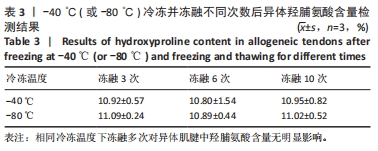
| [1] 张佩,王成,杨军.深低温保存同种异体肌腱的基础研究进展[J].医学综述,2021,27(6):1096-1101. [2] 杨金娟,谢敏豪,黄伟平,等.运动性肌腱损伤研究进展[J].中国运动医学杂志,2019,38(9):809-815. [3] 王晓乐,陈道振,陈坤峰,等.异体肌腱在陈旧性拇长伸肌腱断裂修复中的临床应用[J].实用手外科杂志,2019,33(1):58-59. [4] 史占雷,高顺红,刘德群.同种异体肌腱移植的研究进展[J].中国煤炭工业医学杂志,2007,10(10):1137-1139. [5] 孙文爽,赵建宁,包倪荣.肌腱损伤治疗的研究进展[J].医学研究生学报,2017,30(3):324-328. [6] 段晓杰,王萌,陈丽媛,等.乙醇工艺对同种异体肌腱病毒灭活效果的研究[J].中国药事,2021,35(5):544-551. [7] 赵彦涛,刘思扬,尹惠琼,等.γ射线终末辐照对同种异体肌腱病毒灭活效果及生物力学性能影响的研究[J].中国骨与关节杂志,2018,7(5): 389-393. [8] 沙勇,李福兵,唐辉,等.深低温冷冻保存同种异体肌腱移植修复陈旧性跟腱断裂研究[J].西南国防医药,2014,24(7):707-709. [9] 唐林俊,陈浩贤,崔太安,等.同种异体肌腱修复肌腱缺损的远期疗效观察[J].中国修复重建外科杂志,2011,25(3):341-343. [10] 沙勇,唐辉,丁晶,等.同种异体肌腱解剖重建修复慢性踝关节不稳[J].中国组织工程研究,2014,18(27):4401-4405. [11] LEE AH, ELLIOTT DM. Freezing does not alter multiscale tendon mechanics and damage mechanisms in tension. Ann N Y Acad Sci. 2017;1409(1):85-94. [12] 曾心一,曹俊涛.深低温处理同种异体肌腱移植的生物力学性能实验研究[J].中国医药导报,2007,4(33):76-77. [13] 徐光辉,孙康,徐强,等.深低温冷冻异体肌腱移植的组织学和生物力学研究[J].中国矫形外科杂志,2008,16(24):1883-1886. [14] LANSDOWN DA, RIFF AJ, MEADOWS M, et al. What Factors Influence the Biomechanical Properties of Allograft Tissue for ACL Reconstruction A Systematic Review. Clin Orthop Relat Res. 2017;475(10):2412-2426. [15] ARNOUT N, MYNCKE J, VANLAUWE J, et al. The influence of freezing on the tensile strength of tendon grafts: A biomechanical study. Acta Orthop Belg. 2013;79(4):435-443. [16] SALEHPOUR A, BUTLER DL, PROCH FS, et al. Dose-Dependent Response of Gamma Irradiation on Mechanical Properties and Related Biochemical Composition of Goat Bone-Patellar Tendon-Bone Allografts. J Orthop Res, 1995;13(6):898-906. [17] 徐丽明,邵安良,赵艳红.动物源性生物材料残留DNA的定量检测法[J].生物医学工程学杂志,2012,29(3):479-485. [18] YY/T 1810-2022,组织工程医疗产品 用以评价软骨形成的硫酸糖胺聚糖(sGAG)的定量检测[S]. [19] GB 5009.5-2016,食品安全国家标准 食品中蛋白质的测定[S]. [20] YY/T 1453-2016, 组织工程医疗器械产品 Ⅰ型胶原蛋白表征方法[S]. [21] CABORN DN, SELBY JB. Allograft anterior tibialis tendon with bioabsorbable interference screw fixation in anterior cruciate ligament reconstruction. Arthroscopy. 2002;18(1):102-105. [22] GREAVES LL, HECKER AT, BROWN CH JR. The effect of donor age and low-dose gamma irradiation on the initial biomechanical properties of human tibialiS tendon al lografts. Am J Sports Med. 2008;36(7):1358-1366. [23] MCALLISTER DR, JOYCE MJ, MANN BJ, et al. Allograft update: the current status of tissue regulation, procurement, processing, and sterilization. Am J Sports Med. 2007;35(12):2148-2158. [24] HERNIGOU P, GRAS G, MARINELLO G, et al. Influence of Irradiation on the Risk of Transmission of HIV in Bone Grafts Obtained from Appropriately Screened Donors and Followed by Radiation Sterilization. Cell Tissue Bank. 2000;1(4):279-289. [25] SMITH RA, INGELS J, LOCHEMES JJ, et al. Gamma irradiation of HIV-1. J Orthop Res. 2001;19(5):815-819. [26] NIKOLAOU PK, SEABER AV, GLISSON RR, et al. Anterior cruciate ligament allograft transplantation. Long-term function, histology, revascularization, and operative technique. Am J Sports Med. 1986;14(5):348-360. [27] SCHEFFLER SU, SCHMIDT T, GANGEY I, et al. Fresh-frozen free-tendon allografts versus autografts in anterior cruciate ligament reconstruction:delayed remodeling and inferior mechanical function during long-term healing in sheep. Arthroscopy. 2008;24(4):448-458. [28] DUSTMANN M, SCHMIDT T, GANGEY I, et al. The extracellular remodeling of free-soft-tissue autografts and allografts for reconstruction of the anterior cruciate ligament: a comparison study in a sheep model. Knee Surg Sports Traumatol Arthrosc. 2008;16(4):360-369. [29] NOYES FR, BUTLER DL, GROOD ES, et al. Biomechanical analysis of human ligament grafts used in knee-ligament repairs and reconstructions. J Bone Joint Surg Am. 1984;66(3):344-352. [30] 沙川华,张涛,李龙.人体小腿肌腱生物材料力学特征实验研究[J].成都体育学院学报,2016,42(4):82-86. [31] 吴延平,王英振,焦兆德,等.反复冻融处理同种异体移植兔跟腱组织学及生物力学变化[J].中国组织工程研究与临床康复,2009,13(5):816-820. [32] HUANG H, ZHANG J, SUN K, et al. Effects of repetitive multiple freeze-thaw cycles on the biomechanical properties of human flexor digitorum superficialis and flexor pollicis longus tendons. Clin Biomech (Bristol, Avon). 2011;26(4):419-423. [33] FIDELER BM, VANGSNESS CT JR, LU B, et al. Gamma irradiation: effects on biomechanical properties of human bone-patellar tendon-bone allografts. Am J Sports Med. 1995;23(5):643-646. [34] MCGILVRAY KC, SANTONI BG, TURNER AS, et al. Effects of (60)Co gamma radiation dose on initial structural biomechanical properties of ovine bone-patellar tendon-bone allografts. Cell Tissue Bank. 2011;12(2):89-98. [35] SALEHPOUR A, BUTLER DL, PROCH FS, et al. Dose-dependent response of gamma irradiation on mechanical properties and related biochemical composition of goat bone-patellar tendon-bone allografts. J Orthop Res. 1995;13(6):898-906. [36] GRECO KV, FRANCIS L, HUANG H, et al. Is quercetin an alternative natural crosslinking agent to genipin for long-term dermal scaffolds implantation? J Tissue Eng Regen Med. 2018;12(3):e1716-e1724. [37] RYOU H, TURCO G, BRESCHI L, et al. On the stiffness of demineralized dentin matrices. Dent Mater J. 2016;32(2):161-170. [38] 沙川华,陈孟诗,吴佳,等.人体前臂肌腱生物力学特征实验研究[J].体育科学,2010,30(3):42-45. [39] 尤田,袁树芳,白露,等.跟腱愈合相关机制的研究进展[J].中华骨与关节外科杂志,2020,13(1):84-88. [40] 刘搏宇,李宏宇.肌腱损伤治疗方法的研究进展[J].中国临床新医学, 2015,8(7):700-703. [41] KJAER M. Role of extracellular matrix in adaptation of tendon and skeletal muscle to mechanical loading. Physiol Rev. 2004;84(2):649-698. [42] 万彦林,高冰,王丽敏,等.同种异体肌腱羟脯氨酸测定的正交试验[J].中国矫形外科杂志,2024,32(4):356-361. [43] BERG RA, PROCKOP DJ. The thermal transition of a non-hydroxylated form of collagen. Evidence for a role for hydroxyproline in stabilizing the triple-helix of collagen. Biochem Biophys Res Commun. 1973;52(1):115-120. |
| [1] | Gang Fangli, Dang Zhongxiu, Li Ruiyun, Li Xiao, Sun Xiaoyang. Techniques and performance of biominerals for fabricating bone tissue engineering scaffolds [J]. Chinese Journal of Tissue Engineering Research, 2025, 29(28): 5957-5967. |
| [2] | Jiang Zhixiu, Ji Yuchen, Liu Danyu, Cao Yilin, Jiang Tingting, Song Yihan, Wang Lei, Wang Xinyu. Biomechanical properties of Gyroid structured titanium bionic bone scaffolds for repairing segmental mandibular defects [J]. Chinese Journal of Tissue Engineering Research, 2025, 29(22): 4621-4628. |
| [3] | Zhu Wenbo, Zhang Xujing, Xu Yan, Shi Xintong. Design and mechanical performance of cell-gradient scaffolds based on three-period minimal surface [J]. Chinese Journal of Tissue Engineering Research, 2025, 29(16): 3449-3457. |
| [4] | Wang Huan, Lu Jing, Li Ying, Meng Maohua, Shu Jiayu, Luo Yuncai, Li Wenjie, Dong Qiang. Manufacture and mechanical property on zirconia abutments with a titanium base in dental implant restoration [J]. Chinese Journal of Tissue Engineering Research, 2025, 29(10): 2171-2177. |
| [5] | Wu Zhixin, Jiang Wenwen, Zhan Jianhui, Li Yangshurun, Ren Wenyan, Wang Yiyu. Hydrogels: role and problems in the repair of oral and maxillofacial defects [J]. Chinese Journal of Tissue Engineering Research, 2025, 29(10): 2178-2188. |
| [6] | Cheng Jinhui, Wu Quan, Peng Min, Huang Changli, Tian Huimin, Li Yang. Preparation and properties of selective laser melting of porous titanium at a low energy density [J]. Chinese Journal of Tissue Engineering Research, 2024, 28(5): 664-668. |
| [7] | Wang Jianchun, Yang Shuqing, Su Xin, Wang Hongyuan. Different contents of B2O3 affect mechanical properties and bioactivity of bioactive glass scaffolds [J]. Chinese Journal of Tissue Engineering Research, 2024, 28(5): 712-716. |
| [8] | Lan Weiwei, Yu Yaodong, Huang Di, Chen Weiyi. In vitro degradation behavior of Mg-Zn-Ca alloys [J]. Chinese Journal of Tissue Engineering Research, 2024, 28(5): 717-723. |
| [9] | Wei Yuxue, Wang Di, Liu Xiaoqiu. Design, synthesis and properties of oral composite resin monomers with different photoinitiators [J]. Chinese Journal of Tissue Engineering Research, 2024, 28(5): 731-735. |
| [10] | Zhang Yihai, Shang Peng, Ma Benyuan, Hou Guanghui, Cui Lunxu, Song Wanzhen, Qi Dexuan, Liu Yancheng. Structural design and mechanical property analysis of trabecular scaffold of triply periodic minimal surface with a radial gradient [J]. Chinese Journal of Tissue Engineering Research, 2024, 28(5): 741-746. |
| [11] | Zhang Shaoqun, Zheng Chuanjiang, Liu Jiafu, Jiang Shunwan. Effect of positioning and non-positioning cervical rotatory manipulation on tensile mechanical properties of internal carotid artery with different degrees of atherosclerosis [J]. Chinese Journal of Tissue Engineering Research, 2024, 28(30): 4788-4794. |
| [12] | Huang Yangyang, Wang Shiyu, Liu Hao, Yang Li, Wang Penglai, Yuan Changyong. Effect of sagittal overcorrection design on displacement and stress of mandibular anterior teeth intrusion using clear aligners [J]. Chinese Journal of Tissue Engineering Research, 2024, 28(29): 4593-4598. |
| [13] | Yu Luxiang, Zhang Ruojin, Tan Fabing. Influence of heat treatment technology on mechanical properties of 3D printed titanium alloy specimens [J]. Chinese Journal of Tissue Engineering Research, 2024, 28(29): 4741-4747. |
| [14] | Huang Jie, Shi Yanghua, Tan Zhen, Bo Zhandong. Free vascularized fibular grafting in treatment of femoral head osteonecrosis [J]. Chinese Journal of Tissue Engineering Research, 2024, 28(21): 3373-3379. |
| [15] | Shi Liu, Liang Pengchen, Chang Qing, Song Erhong. Application of machine learning in key properties of medical metal materials [J]. Chinese Journal of Tissue Engineering Research, 2024, 28(17): 2766-2773. |
| Viewed | ||||||
|
Full text |
|
|||||
|
Abstract |
|
|||||
